Nele Strobbe is Head of the Plaster Cast Workshop at the Royal Museums of Art and History, Brussels
The plaster cast of Michelangelo’s David at the Victoria and Albert Museum has, in addition to his ‘cousin’ in the Pushkin State Museum of Fine Arts in Moscow, another one in Brussels. Currently most of this David is to be seen in the Brussels plaster cast workshop, a department of the Belgian Royal Museums of Art and History.
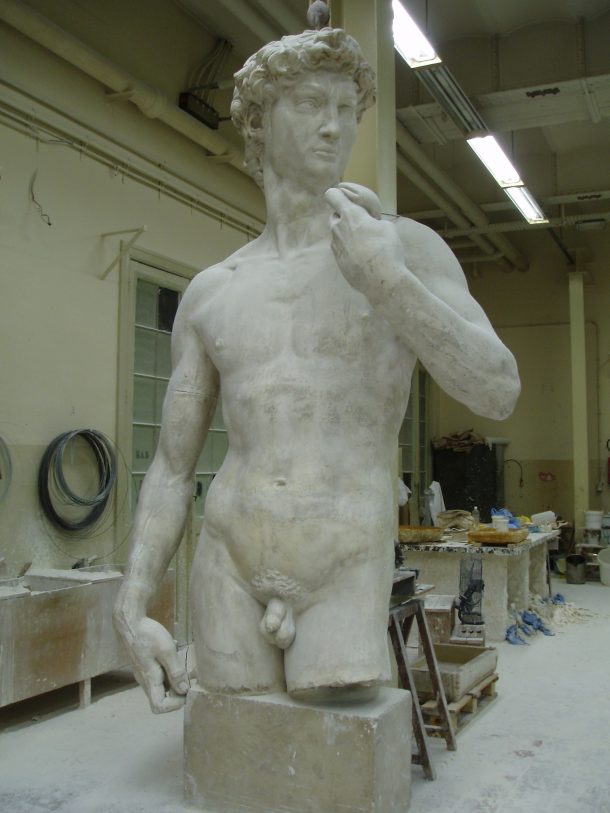
David (inv. no. 3580-8; corresponding mould inv. no. 3110) surveys from a high viewpoint the daily activities of the plaster cast craftsmen in the Brussels workshop. But the figure was not always located in this busy spot. It comes from the historic plaster cast collection of the Belgian Royal Museums, and was probably acquired in the 1870s.
The Brussels plaster cast collection
The Brussels plaster cast collection came into being when two 19th-century Brussels collections were combined: the Musée des Plâtres (the Museum of the Plasters) which originated in the plaster cast collection of the former Musée royal de Peinture et de Sculpture (the Royal Museum of Painting and Sculpture), was once used for teaching purposes. Secondly the Musée des échanges (Museum of Exchanges) amassed plaster casts acquired by the fledgling Belgian state. During the reign of King Leopold II, Belgium participated enthusiastically in the international exchanges which were taking place between those European countries who had signed the ‘Convention for promoting universally reproductions of works of art for the benefit of museums of all countries’ in 1867.
From 1888 onwards both collections were housed under the same roof of the museum palace at the Parc du Cinquantenaire, which now houses the Royal Museums of Art and History and the Royal Museum of Military History of Belgium. At that time the Brussels plaster cast workshop was established in order to manufacture plaster casts for international exchange.
By 1926 the collection encompassed more than 4000 plaster casts and corresponding moulds. A complete chronological inventory was made by Henry Rousseau, curator of the plaster cast collection at that time: H. Rousseau, Catalogue sommaire des moulages, Musées royaux d’Art et d’Histoire, IIIe section, Bruxelles, 1926. This catalogue lists statues, figurines, reliefs, heads and busts, architectural and ornamental details, from Prehistoric times up to the 18th century. They were mainly European, but also embraced Egypt and Mesopotamia. The sections included Greek and Roman antiquity, the Middle Ages, Renaissance and ‘Modern Times’.
For several decades the collection of monumental and smaller plaster casts was displayed in the museum galleries, more precisely in the North wing of the Cinquantenaire Palace, the Bordiaux Hall, currently the Royal Museum of Military History.
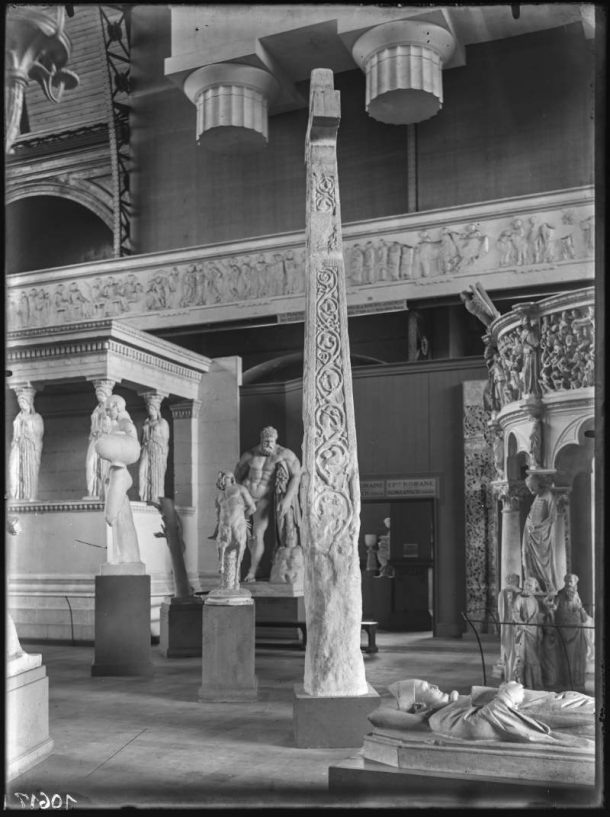
Puzzlingly however Michelangelo’s David is not to be seen in early photographs of these galleries. Did the figure arrive somewhat later? Or was the magnificent plaster cast exhibited in another museum department, or perhaps not exhibited at all, because of its scale, or the problem of displaying it safely in stable conditions, due to its large size? If we are able find out more about its history, we will happily share it with colleagues elsewhere.
In the early 20th century, with the development of photographic reproductions and increasing opportunities for travel, plaster casts began to lose their documentary and educational importance. As a result they disappeared from many museum galleries, to be replaced by other non-reproductive objects.
Nevertheless the Brussels plaster cast workshop continued and continues to function. Plaster copies have were produced for more than a century. Even today visitors are welcomed to the workshop to learn more about the almost forgotten craft of plaster cast production, to breathe the 19th-century atmosphere kept alive here, and sometimes to purchase plaster examples for themselves. And at the same time they can admire the impressive plaster cast of Michelangelo’s David in this extraordinary environment.
When did David arrive in Brussels?
Thanks to Johanna Puisto, Sculpture Conservator at the V&A, we have been studying the plaster cast of Michelangelo’s David. She contacted us with some specific questions. Because of this, in spring 2015 I contacted my colleague Mme Monique de Ruette in the museum archives. She was most enthusiastic about the project, and tried to help us establish if there was any more information about the cast’s origin and its arrival in Brussels. The documents which Mme de Ruette found may relate to its arrival in Brussels, and imply a date of around 1875.
On 1 September 1874 the Gazette de Cologne noted that ‘the German government, with the agreement of the Italian government, had commissioned some Florentine artists to make some new plaster casts, assisted by the famous Florentine bronze founder ‘Papi’, [Clemente Papi (1803-1875)]. This provided Belgium with a good opportunity to order copies of the same sculptures for the Belgian state without having to take casts from the original sculptures once again.’
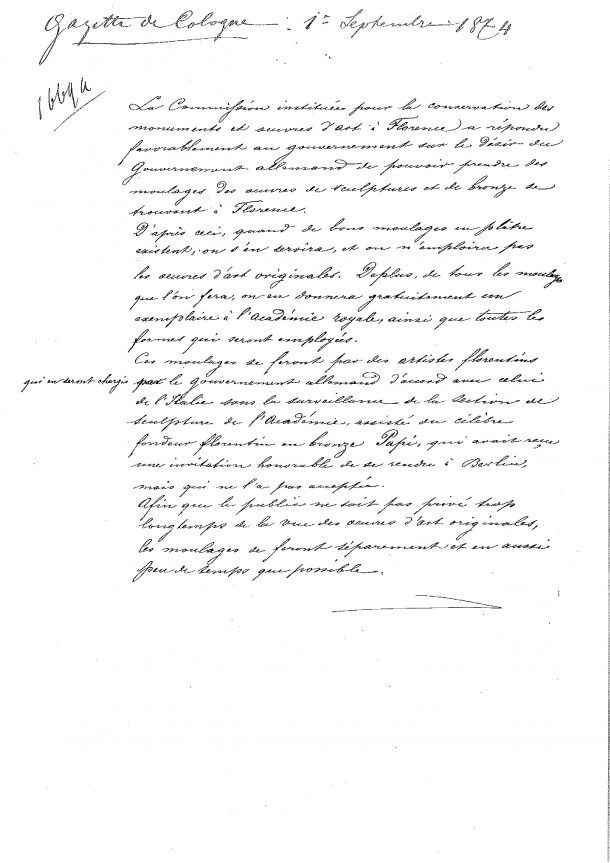
On 10 September the Belgian Minister of Internal Affairs requested permission from the Minister of Foreign Affairs to order some plaster casts of ‘oeuvres de sculptures et de bronze se trouvant à Florence’ (sculptures and bronzes located in Florence).
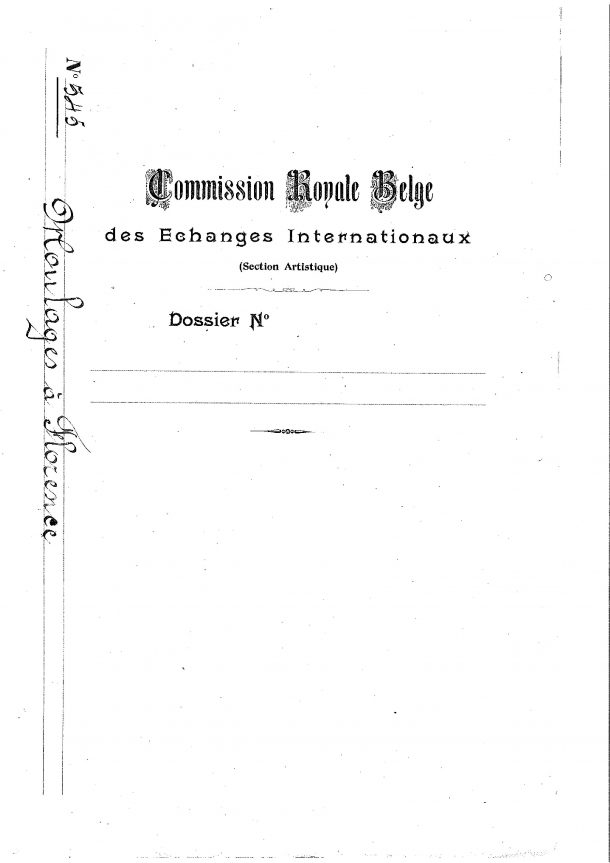
This request was repeated on 21 June 1875 and followed by an answer on 7 July, specifying that the commission in Berlin was considering this request, and they waited a response from the delegates in Florence. Unfortunately a detailed list of the sculptures and bronzes was not found with these documents. But even if the cast of David was not mentioned specifically, it was possibly part of this order. We hope further archival research may clarify this.
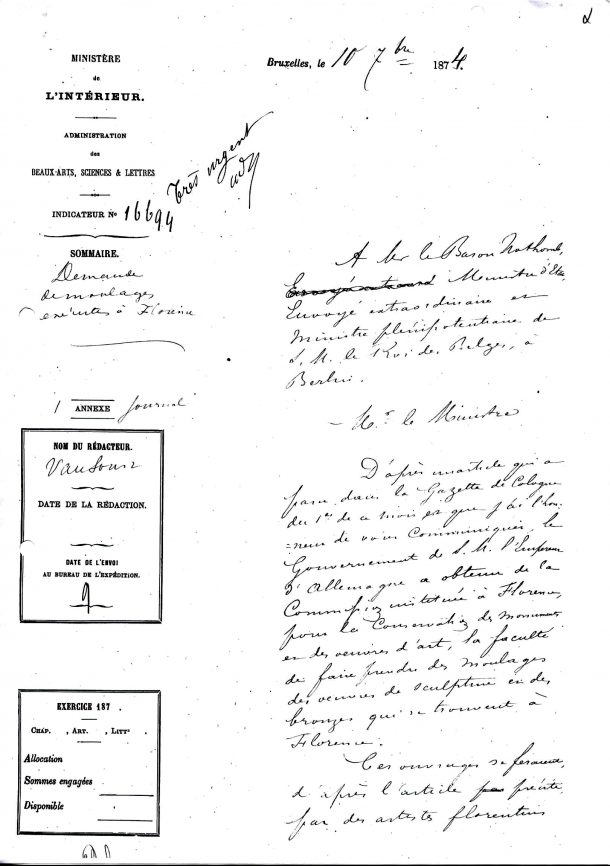
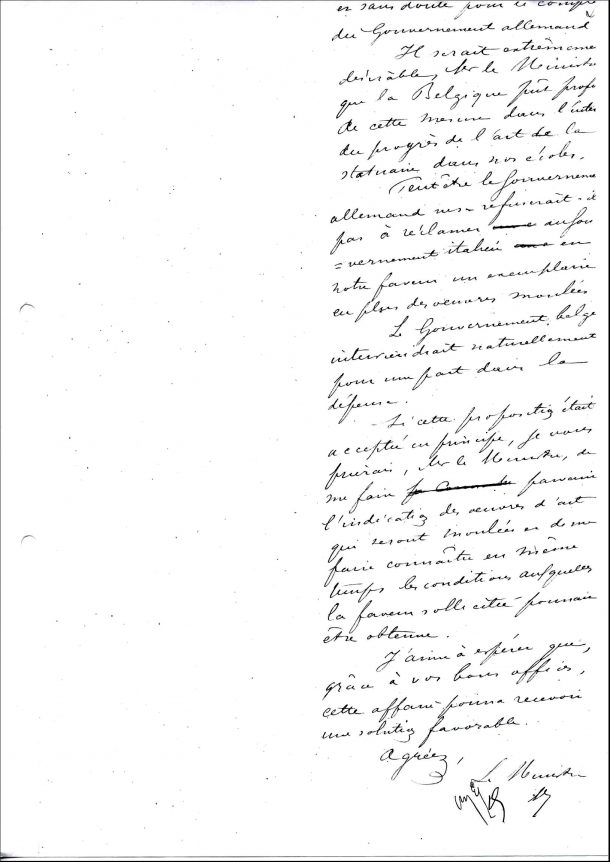
The mould of the head of David and some reproductions made of it
As mentioned above, today the cast of Michelangelo’s David is centrally placed in the plaster cast workshop. Conversely the corresponding mould is not on display, and instead sits on some shelves in a large store. Strangely enough, even though the mould was assigned a number in Rousseau’s catalogue of 1913/1926, namely 3110, it is far from complete. Only the mould of the head now exists. Is it the sole part that has survived or, more probably, is it the only part of the whole figure from which a mould was made? The mould’s existence means that life-size reproductions of David’s head can still be produced in the workshop. This piece-mould, composed of 196 numbered pieces, is in good condition.
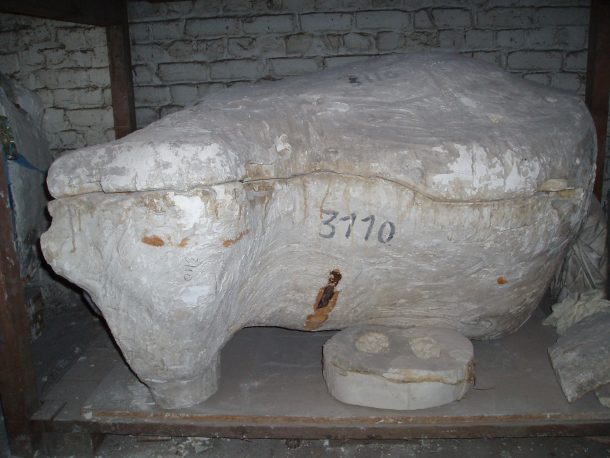
My colleagues, the craftsmen in the studio, Thierry Demulder and Jan Swartenbroekx, who have been working here since 1998 and 2001 respectively, remember having executed two orders for plaster reproductions of David’s head, both for private clients. To track down any earlier orders of the head would require further archival research. Its large size is probably the reason for the limited number of orders.
More frequently the mould is used for production on a smaller scale: one fragment of the head is particularly popular with the workshop’s visitors and clients: the left eye of David, followed by the two ears. These small plaster objects have a timeless and surprisingly modern character.
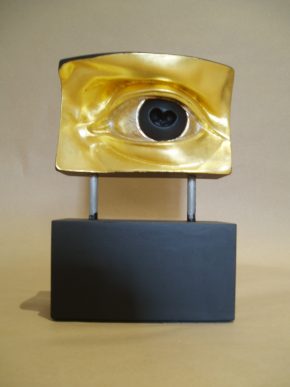
The white plaster copy of David’s left eye inspired the artists Virginie Bolle and Eglantine de Tercelyn, specialists in the application of patinas (simulating other materials such as stone, bronze, wood, ceramics etc.) and gilding. With gold leaf and black paint they created a decorative interpretation of this fragment.
Still the original copy?
The fact that a mould of the whole figure does not exist, but only one for the head, reinforces the idea that the plaster cast of David today displayed in the workshop is the original and unique exemplar in Brussels. Probably acquired by the Belgian state at the end of the 19th century, it must have been made in Italy. Is the Brussels plaster cast the work of the aforementioned Florentine artists, assisted by Clemente Papi, who also created the V&A’s cast of David? The plaster cast is in good condition, even though the lower half of the body is stored separately in pieces after more than a century, and is clearly of high quality.
A closer look
No restoration has been carried out on the cast; nor has it been the subject of any serious research. A closer look however reveals some technical details.
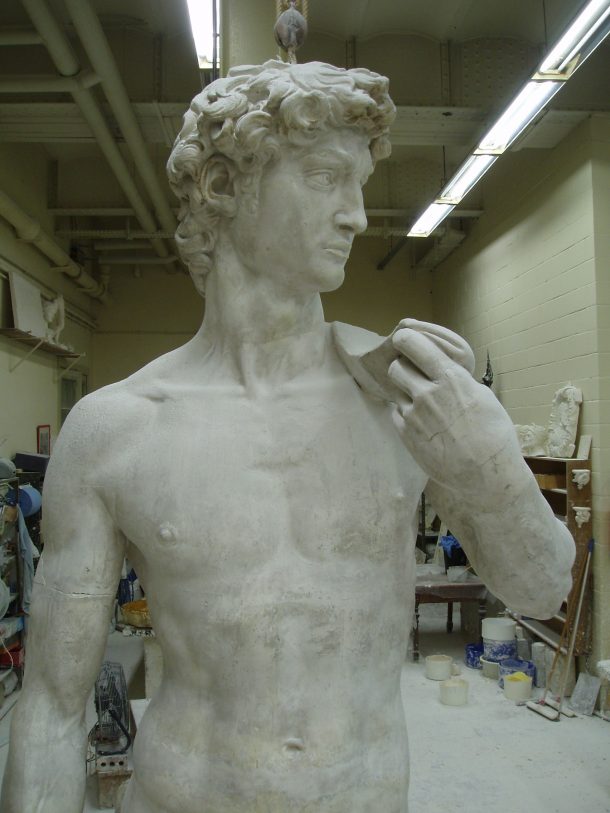
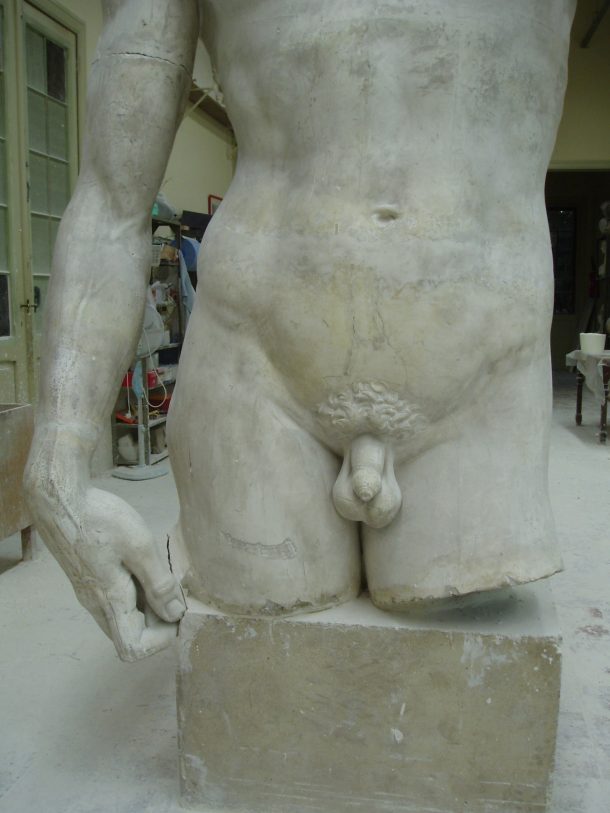
The plaster cast has been created from a piece-mould. The cast has not been entirely finished, and so many of the joints are still visible. Do these lines correspond with those on the casts in London and Moscow? Could this indicate that these different casts were created from the same Florentine mould?
The construction is solid. The head, torso and base are hollow. Inside the torso at three levels a horizontal wooden support is placed, from the front to the back. To the lower wooden support is added another wooden crossbar. The plaster wall, probably backed with hessian, widens from the top downwards and is very thick at the height of the upper legs. The arms are reinforced with a metal armature. The workshops ceiling being too low for the full-length statue, only the upper part of the plaster cast is assembled and exhibited. The legs are stored offsite. They are of thick plaster with a metal armature, and possibly reinforced with natural fibrous material.
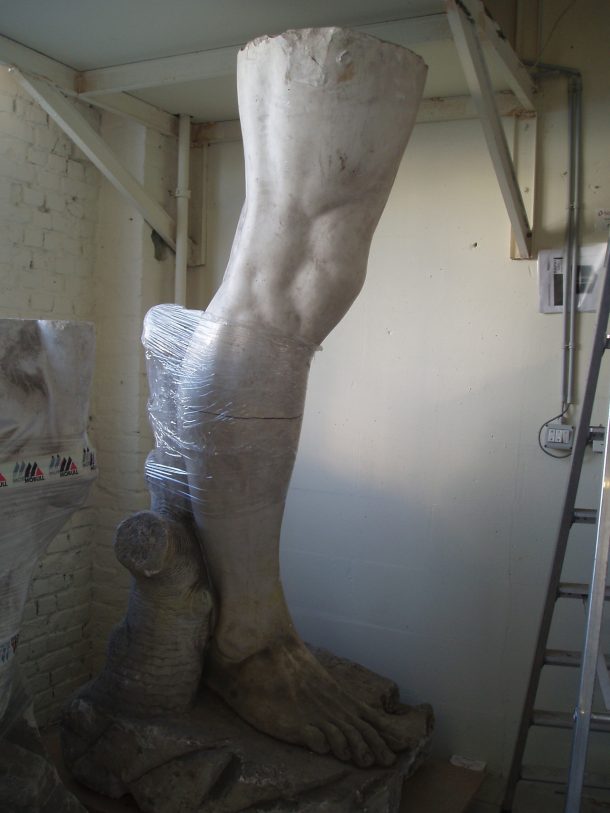
The surface is slightly shiny and smooth. It has evidently been sealed to reduce the porosity of the plaster. Perhaps it was treated with some kind of soap, but in any case it was not painted. There are stains, some small splinters and cracks and a few bigger gaps are visible. Most of them are old, a few more recent.
Assembling the cast
The gigantic plaster cast is composed of nine separate parts: the head, torso, base, left arm, left hand, right arm, right hand, and the left and right leg (which are not currently assembled with the rest of the body). The last time the figure was assembled, when the David was placed in its present dominant position in the plaster cast workshop, dates from 2005. The assembly was carried out by the two craftsmen still in the workshop today. They explained that the different components were carefully fitted together. Afterwards they were attached to each other with hessian, clay and plaster glue. Metal bars were only used to mount the left and right arm to the torso. The assembly is reversible.
This tall statue is fixed to the pillar behind metal bars at the height of the shoulders and at the lower back with a strong wire and pulley system. The head is tied to the ceiling. At the edges of the individual parts, some flakes are visible. These are caused by vibrations of the tools used to detach the separate parts. They indicate that the plaster cast was assembled and disassembled more than once.
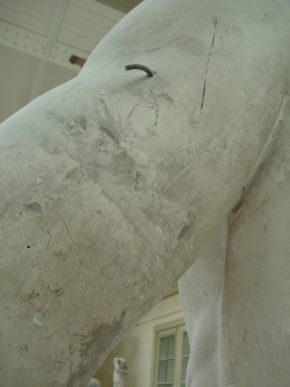
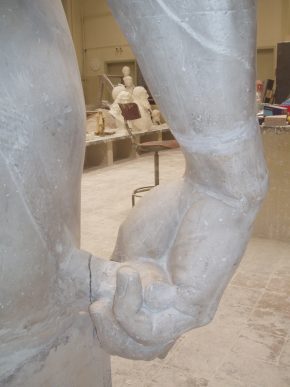
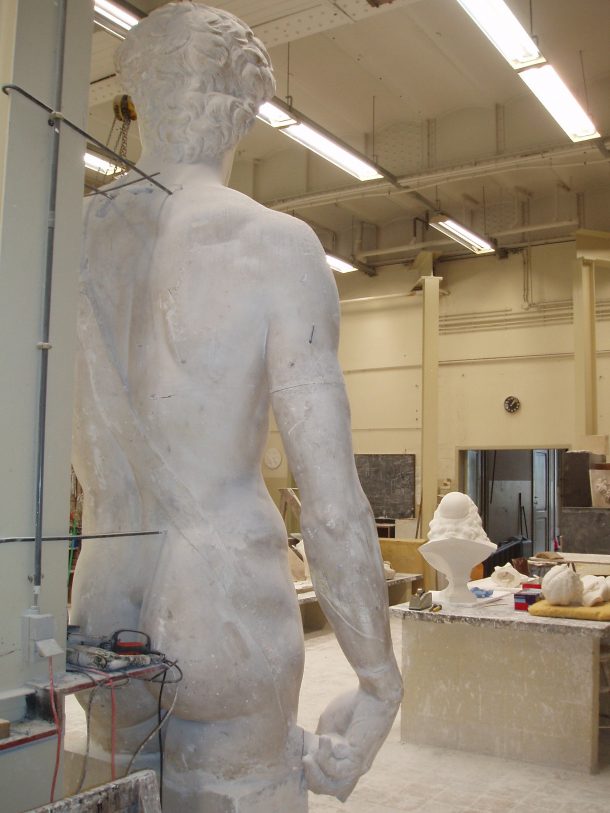
International exchange
Johanna Puisto (Sculpture Conservator at the Victoria and Albert Museum, London) and Irina Skoptsova (Curator of the plaster cast collection at the Pushkin State Museum of Fine Arts, Moscow), initially made enquiries about our cast in order to learn more about it. This led to a useful evaluation of its original context and condition. With luck this research will lead to a greater understanding of this monumental piece. There are still archives to be studied, while the plaster cast itself, never previously treated, restored or closely studied, may reveal more of its secrets.
The information shared between colleagues of different museums furthers our knowledge about each individual copy, since they must all be linked historically. Directly or indirectly every copy goes back to the original marble masterpiece by Michelangelo. Many of the copies originate in the international exchange ‘for the benefit of museums of all countries’, under the international convention of 1867.
The present day exchange of information is in many ways a fruitful sequel of this enriching international collaboration. We are delighted to participate in it, and greatly look forward to hearing more about the various plaster casts of David in the months and years to come.
Acknowledgements
Many thanks to Dr. Holly Trusted, Senior Curator of Sculpture at the V&A for editing the text.
Bibliography
H. Rousseau, Catalogue sommaire des moulages, Musées royaux d’Art et d’Histoire, IIIe section, Bruxelles, 1926.
V. Montens, Les moulages des Musées royaux d’Art et d’Histoire, Bruxelles, 2008.
Practical information
The plaster cast workshop of the Royal Museums of Art and History is open to the public from:
Tuesday to Friday: 9:30 – 12:00 am and 1:30 pm – 4:00 p.m.
For more information see here.


